
As a child I always imagined elephants to be big, loving, cuddly creatures that were intelligent, thoughtful, and benevolent. Western media, and especially children's stories such as Babar, generally portrayed elephants in a very positive light as beautiful, majestic, sweet and charismatic.
But in Africa, elephants can have a different reputation. Some people view elephants with fear as animals that destroy their precious crops and sometimes even trample people to death. They are dangerous, to be respected and feared.
This article is about my attempts to relate to farmers in sub-Saharan Africa to discover more about their experiences with elephants and to get a sense of what might be some possible solutions to human-elephant conflicts, often referred to as HEC. After researching human-elephant conflict studies, as well as having my own personal experiences with those who have been subjected to elephants raiding their crops, I hope to establish that human-elephant conflicts are, in many cases, a by-product of extreme poverty. Therefore, to address the HEC, one must address poverty.
The Reality at Kisigau, Kenya
A native Kenyan working on his master's thesis at Western Kentucky University, Simon Kasaine alights from his motorcycle and greets a farmer who lives just miles from the boundary of Kenya's enormous Tsavo National Park near the village of Voi in the Taita District of Coast Province. The park is divided into east and west sections by the A109 road and a railroad. The Tsavo River, which inspired the park’s name, runs through both sections of the park. Walking with the farmer Ayub Bushike Kadenge through trampled corn, we see the remnants of a bonfire Kadenge set the previous night to keep away the elephants. Simon points at the ashes, explaining to me, "Farmers light fires to scare the elephants, but it doesn't always work. The farmers make noise, shine flashlights, light fires, but if an elephant wants to eat, he will eat." 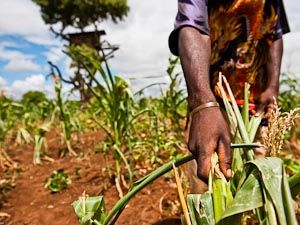
"This is damage from a single lone bull," says Simon. “This male might rejoin a large herd and lead them back here to this field, like a scout.” The larger herds will come a few months later in the late dry season
Simon has been studying the farmers’ struggles to prevent crop damage from elephants in Kisigau, Kenya, for several years. It's not so much the crops that the elephants are after, he explains, but the search for water that brings the elephants to human settlements, like here at Kisigau. By the middle of the dry season each year, water sources near Tsavo become scarce. Residents of Kisigau, for example, depend on water trucked in by the government. Each family gets one hundred liters per week, not enough to fill a bathtub. In addition, there are some small ponds of water left from the rainy season that are used to wash clothes and water livestock. One herd of thirsty elephants can drain such a pond in a single evening. 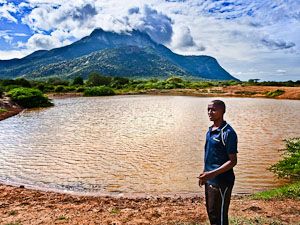
Simon cites some methods that do deter elephants. "Chili," he explains, "elephants hate chili. If the farmers put it on their crops, then elephants won't eat them. We are investigating this possibility.” Another elephant deterrent method that is being investigated is to use chili like pepper spray. Chili is mixed with elephant dung and set afire. But even the chili approaches ultimately fail, explains Simon, due lack of economic viability. "Most farmers here cannot afford chili," Simon explains. "In fact, [lack of money] is why most ideas don't work here.”
Ideas that do work cost money: Enormous electrified fences work; sensors that alert trained staff who come in jeeps to repel the elephants work. Elephant birth control might work, but it involves helicopters, trained personnel, and other lavish expenses. Another method under discussion is a collaring system. The matriarch of a herd is collared, and when she gets close to crops, every farmer in the area will receive an automated text message that alerts him or her to prepare their chosen method of crop protection. This method can be contentious though, as some researchers like Barbara McKnight have found that collaring can lead to elephant injuries and other problems. 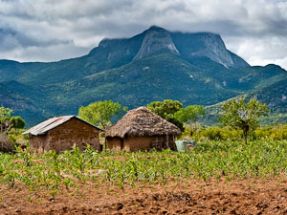
Methods that cost a lot of money generally are not feasible for farmers in Kisigau, most of whom live at the margins of survival. Many children are malnourished and undereducated. Disease is a constant threat. Many rural peoples live by subsistence farming, meaning the crops in the fields are this year's food. Most people in Africa are rural farmers who eke out an existence from land that often has very little to give. Seasons are harsh, with nine months of drought per year the norm. The rural economy allows for little income generation besides small-scale businesses and cottage industries such as charcoal production. Any solution to human-elephant conflict (HEC) must take into account the fact that the choices people must make are severely limited by their economic circumstances.
Elephants Are People Too
After Simon shows me around Kadenge’s land, he introduces me to Kadenge's brother. In an animated and good-humored manner, Kadenge's brother explains how the elephant came the night before last and ate about an eighth of the corn crop. He points out how he and his family hid in their tiny hut with a fire burning outside as the bull elephant made his way through their produce. "They don't take the corn that is bug-eaten," Simon translates for him. "They only take the good, healthy corn." "You mean elephants are picky?" I ask. "That is correct,” he says. “They know what they like. The corn is very good for them; it is very easy on their teeth and nutritious."
Farmers try all kinds of things to prevent elephant damage. Sheets of metal siding dangle from trees in the wind. Simon says that at best, the elephants ignore them, and at worst, they serve as markers for where the good stuff can be found. Sometimes there are fences of thorns and other barriers that elephants tend to disregard. I almost run face-first into a single strand of barbed wire erected at about eye-level. "A backscratcher for elephants?" I ask Simon. 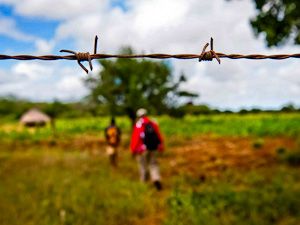
We discuss how difficult it is for farmers to keep an eye on the crops and to scare an elephant away if one does appear. Men are often gone to the cities to make money, leaving too few family members to watch the fields. Likewise, children are often in school. Even if they were present, there is not much they can do. While the bore well a few miles from the farm provides a permanent water source for locals, even in dry season, the construction of this artificial water source attracts elephants when the water holes in the bush run dry.
It’s difficult for me to hide my sympathy for the elephants. I was raised with the idea that elephants are sentient, and indeed should be considered to be like people – not human beings maybe, but people nonetheless. We know, for example, that they have complex interpersonal relationships and mourn their lost family members for years after their deaths. They have "handshakes” and give each other "hugs". They experience trauma and post-traumatic stress disorder. They learn over their long lives and share their knowledge with other elephants. Many aspects of elephant behaviors eerily reflect our own human emotions and behaviors.
The Real Problem
Human population growth and the accompanying habitat destruction are the primary causes of declining elephant populations today. Beginning in the late colonial era, governments began to cull elephant herds to protect crops. Thousands of elephants were killed every year by colonial governments to protect farmland. Today elephants are protected and poaching is minimal compared to previous decades, but parks are often so small that the elephants do not have enough space to range naturally. Local governments often call for culling elephant herds as a solution.
But culling produces a lot of problems as well. For example, one study found that culling random elephants caused upheaval in elephant social structures (Southwood 1977).Young bulls and other displaced and traumatized elephants then united into large, destructive herds that were more likely to damage crops. Traumatized elephants clearly do not respond too differently from humans. Their enormous size and aggressive behavior make them frightening to those whose crops have been raided by them.
The sad reality is that there simply is not enough space for both humans and elephants in the Kisagau area of Kenya and throughout many areas of sub-Saharan Africa. Even small numbers of wild elephants need a substantial range to survive. In general, throughout Africa, elephant grazing patterns demand far more space than is currently allotted in national parks. Protected areas where elephants live are often marginal lands that are prone to drought. Elephants and the people are fighting for the same meager resources, and people often question why they should give up potential food resources to feed wildlife instead. The concept of expanding protected areas for elephants upsets those who encounter elephants on a regular basis, especially farmers who are hungry and have to depend on the government to provide drinking water in the dry season.
I believe that the conservation movement will only be successful if it focuses on connecting animal rights with human rights, especially if it wants to engage the farmers in sub-Saharan Africa who come in frequent contact with wildlife.
To many Africans, wildlife is to be feared or to be eaten, not watched and admired. Given the dangerous animals many encounter, their mindset is easy to grasp.
To get a sense of what could happen to East and southern African elephant populations in the next fifty years, take a look at elephant populations in West Africa. There, the human population densities are higher than in eastern and southern Africa, and wildlife, especially megafauna, has been drastically reduced and squeezed into small pockets of protected land. Unlike the bustling parks in some of Africa, West African national parks, such as Parc National du W in Benin, feel eerily empty; in my trip to the well-advertised park in February 2010, I failed to see a single mammal!
Crop raiders
To understand the problem of elephant crop invasion in a broader context, we first need to examine the economics of subsistence farming and how most crops are lost. A majority of studies indicate that about half of all subsistence farming crop production in Africa is lost to pests, pathogens, and weeds. Evidence suggests that elephants account for a very small proportion of crop damage. And domestic livestock accounts for more damage than all wildlife combined (Gesicho 1991; Gillingham and Lee 1999; Hawkes 1991; Mascarenhas 1971).
Over time small animals such as baboons and rats eat far more crops than larger animals do. However, when elephants do invade fields, they inflict sudden catastrophic damage that can destroy a family’s food supply. A farmer's entire crop might be eaten by a single herd in a single evening. It is these sudden, irrevocable losses, combined with the threat of trampling, that cause rural farmers to dislike elephants.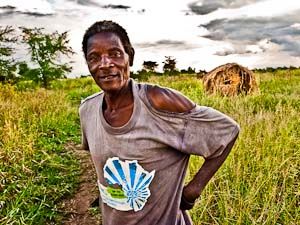
Mr. Jitanga of Machinga District, Malawi, and his family live at the edge of Malawi's Liwonde National Park. When we visited him, he was guarding from a small hut overlooking an elephant-sized hole in the park fence that runs along his corn fields. "The hippos don't eat so much, and the baboons take some of the melons, but the elephants can destroy an entire year's crop in one sitting," he related. "A family member must stand watch almost every hour of the day.” When elephants come, he explained, the family tries to scare them away with flashlights, fire, and noise. If all that fails, they run two miles to find park rangers who might fire blanks at the elephants, if they happen to have any.
Unfortunately, the government does not compensate Malawian farmers for their crop loss due to wildlife consumption. Jitanga's community sees no direct benefit from tourism in Liwonde National Park, except for the occasional sale of trinkets to tourists. The park restricts his tribe’s access to firewood, hunting, and age-old fishing grounds. Like many poor Africans, the community is openly hostile towards conservation efforts. Until ways can be found for wildlife conservation to benefit people living in extreme poverty, such as Mr. Jitanga's family, the long-term prospects for many animals living in and around the protected areas hangs in the balance.
Many traditional African societies, such as Mr. Jitanga’s used to be communal in nature. The social order of the village and extended family protected against catastrophic crop losses caused by elephants. But today, agricultural and social patterns focus more on individual plots of land and individual ownership. The breakdown of traditional social networks has resulted in more individual farmers being unable to cope with massive elephant damage.
Researchers at the University of Wisconsin Zoology department (Naughton, Rose, and Treves 1999) have found that collective decision-making and distribution of risk can be effective tools that help communities cope with elephant-caused losses. Another successful elephant deterrent was used by a village living near a protected forest in Gabon. They planted crops in a new pattern planting cacao around their food crops. The result was a dramatic decrease in crop raiding compared to a control village nearby. Other villages have created systems whereby farmers who lose crops to elephants are assisted by other farmers through a mutually beneficial village crop insurance program.
Under pressure to cope with crop losses, individuals without extended family or other societal structures to help them often resort to strategies that have negative effects on conservation efforts, such as snaring and hunting wild animals for bush meat. Other people resort to commercial charcoal production, which causes further deforestation of the savannah upon which humans and elephants depend. Although less common, some people simply kill elephants or turn to poaching. 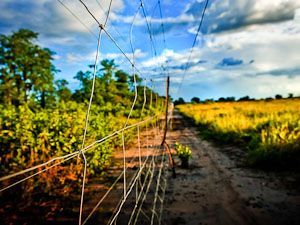
Niger – The End stage of Subsistence Agriculture
In Niger, where the elephants are gone and the giraffes are soon to follow, the average woman has eight children in her lifetime, the highest birth rate in the world. Crop damage from large animals, mostly hippo, is a problem close to the River Niger, the country's only permanent body of water. The rest of the country is dry, mostly barren, and markedly overpopulated. "The worst a country could be without a war," commented Tim, a Peace Corps volunteer. The high birth rate coincides with a high death rate, but the net effect is still positive population growth. Every year in Niger, there is hunger and famine as the previous year's crops run out and the next are not yet ready for harvest. Most women marry sometime after puberty and have several pregnancies in their teens.
According to the World Health Organization, one in five children does not live to age five. If one does survive, one spends a lifetime fighting disease and malnourishment. Death in Niger is a daily part of life ,and little thought is given to long-term planning. Subsistence agriculture as practiced in the rest of Africa follows more or less the same pattern as in Niger. The population increases. The need for more food increases. Farming increases where possible. Deforestation increases as people search for fuel and building materials and as they clear land for growing crops. Over time, the soil is depleted of nutrients and barely supports hardy weeds and grasses. Livestock pounds what grasses are left to dust, and uninhabitable desert expands into what were once lightly forested savannah grasslands. 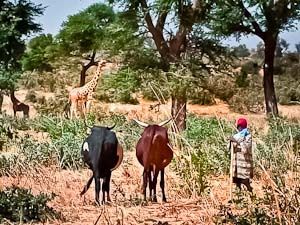
Conclusion
Effective conservation efforts link helping wildlife to helping communities. Such efforts include reducing poverty, empowering women, providing families, including women, with access to healthcare and reproductive care, providing girl children access to education, and setting up ways for communities to benefit from the parks they live near (community-based conservation). When this is done well, wildlife and elephants have a better chance to survive.
References
Gesicho, A. “A survey of the Arabuko Sokoke elephant population” (Unpublished report, Kenya Wildlife Service Elephant Programme, Nairobi, Kenya).
Gillingham, S., and P. Lee. “The impact of wildlife-related benefits on the conservation attitudes of local people around the Selous Game Reserve, Tanzania.” Environmental Conservation 26(1999): 218-228.
Hawkes, R. K. “Crop and livestock losses to wild animals in the Bulilimamangwe Natural Resources Management Project Area.” Center for Applied Social Sciences, University of Zimbabwe, 1991.
Mascarenhas, A. “Agricultural vermin in Tanzania.” In Studies in East African Geography and Development. Edited by S. H. Ominde. Berkeley: University of California Press, 1971.
Naughton, L., Rose, R., and Treves, A., “The social dimensions of human-elephant conflict in Africa: A literature review and case studies from Uganda and Cameroon.” Report to the African Elephant Specialist, Human-Elephant Conflict Task Force of IUCN. Glands, Switzerland, December 1999.
Southwood, T. R. E. “Habitat, the Templet for Ecological Strategies?” Journal of Animal Ecology 46 (1977): 336-365.